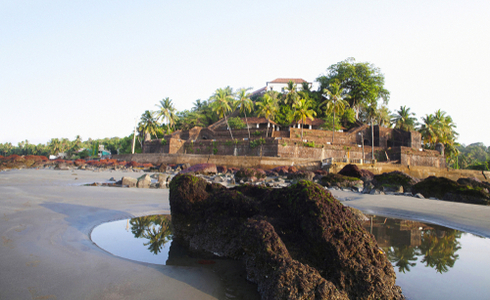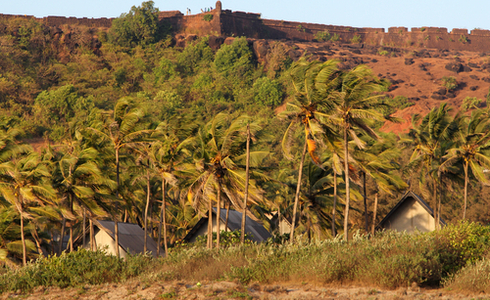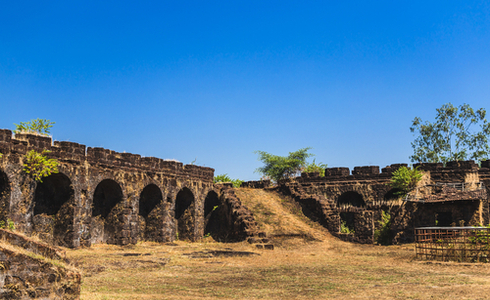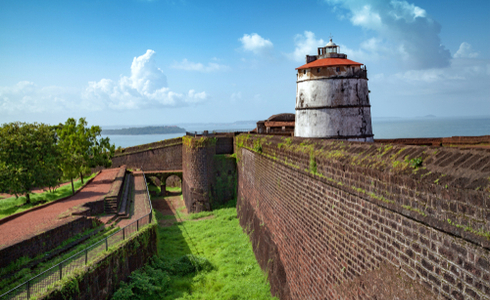January 31, 2020
Explore 6 Most Popular Forts in Goa with Family

Revati Nargund
Think Goa, and you are flooded with images of picturesque landscapes, soft ocean sand caressing your wet toes and of course, the white sandy beaches. You can enjoy a lovely sunbath, indulge in some water sports or sit back and marvel at a sunrise or a sunset. However, moving away from the coastline, there are many heritage places in Goa which are worth visiting! Though the state is small, its multitude of rivers, canals, imposing forts and associated monuments create rich tapestries providing a glimpse into what Goa stood for, in earlier times, besides beaches. For example, visit the forts in Goa and be privy to some enchanting tales resonant of courage and gallantry. Meander through these forts and experience magic, first hand.
From early settlers, explorers and traders from distant shores to modern-day tourists, Goa has remained charismatic from time immemorial. Forts in Goa are associated with interesting historical facts and anecdotes. These heritage places in Goa also boast of unique architecture prevalent in those times drawing influences from various corners of the world from where early settlers first set their foot in Goa.
Here’s a list of forts in Goa you must take time out for, especially if you’re a history buff and would like to discover Goa beyond its golden beaches.
|
Sr No |
Forts in Goa |
Timings |
|
1 |
Reis Magos Fort |
9.30 am to 5 pm |
|
2 |
Chapora Fort |
9 am to 5 pm |
|
3 |
Corjuem Fort |
6 am to 7 pm |
|
4 |
Mormugao Fort |
7 am to 5.30 pm |
|
5 |
Fort Aguada |
9.30 am to 6 pm |
|
6 |
Nanuz Fort |
8 am to 6 pm |
1. Reis Magos Fort, South Goa
Timings: 9.30 AM to 5 PM
On the banks of the river Mandovi is Reis Magos, a village in Goa opposite to Panjim, the capital of Goa. The village is famous for one of the oldest Portuguese forts in Goa, the Reis Magos Fort. The meaning of Reis Magos is ‘Three Wise Men’. It was built to protect the narrowest stretch of the Mandovi estuary. Renovated and restored today, this well-maintained and quaint space is surrounded by pristine natural beauty. Reis Magos is now like a nerve centre of the culture and heritage of Goa and one of the forts in Goa that should definitely be on your ‘must see’ list.
Built in the 1400s, the fort has served as a hospital and prison, apart from being initially constructed and used as a defence fortress.
History & Architecture
An ancient fort strategically located for defence, the history of this fort is significant and exciting. Situated at the tip of the Mandovi river, Reis Magos was the most suitable point from where Old Goa could be defended against enemy infiltration. Long histories of wars and annexure triggered the Portuguese to fortify their area, and hence the construction of Reis Magos fort began in 1551. From the Dutch to the Portuguese to the British, from noblemen to armies, freedom fighters to convicts, the fort has served them all through centuries of invasions. Today, it is restored and speaks in aplomb of the history it carries. Do visit this place if it is the forts in Goa that’s on your mind.
Made of laterite stone, the architecture of the fort is a blend of the Maratha and Portuguese styles of architecture. Visit the citadel and bastion to get a sense of the grandeur this structure once exuded. You can also visit the artefacts preserved till date at the fort and the church built during earlier times within its premises. The surrounding beauty is another alluring factor for tourists. Today this fort can be rented for weddings, receptions, shoots, fashion shows and such other events.
2. Chapora Fort, Bardez, North Goa
Timings: 9 AM to 5 PM
Located in the Bardez district, the Chapora Fort offers a stunning view of Vagator Beach. You can take a bus or a cab from the Mapusa river to reach this fort.
Rising against the Chapora river, among the many forts in Goa, this one wears a unique feather in its cap. Portions of the film Dil Chahta Hai was shot here. It’s best to visit this fort in the evenings and enjoy a sunset among some beautiful ruins. This is one of the best heritage places in Goa in terms of the breathtaking views it offers atop a cliff facing the sea. The Chapora fort is very popular among tourists. Chapora overlooks the Vagator Beach, Morjim and Ozran beaches and the Chapura River.
History & Architecture
Forts in Goa speak of ancient tales, architecture as well as about its people and tribes, and Chapora is no exception. Built in the 1500s, the fort was fought for by both, the Marathas and Portuguese. The final structure, as it stands today was built in 1717. The walls have tufts of natural green grass growing all over. For a long time, this fort was assumed to be insurmountable because of the natural vegetation. But the Marathas did so with ease, impressing the Portuguese into surrender.
3. Corjuem Fort, Bardez, North Goa
Timings: 6 AM to 7 PM
Aldona is a little hamlet in North Goa in the district of Bardez. Famous for its homestays and villas in Goa, it is also close to the island fortress, Corjuem Fort. Corjuem is one of the two island fortresses of Goa. The Mapusa River separates the village of Aldona and the Corjuem Fort. You can get across to the fort by walking past a lovely suspension bridge. This bridge and the surrounding breathtaking views have caught the attention of tourists.
History & Architecture
Built in the 1500s, it originally belonged to the Bhonsales clan. It was used as a military school in the 1800s.
Corjuem fort is made of laterite stones with bastions for cannons in four corners. Apart from dwelling quarters and a well, there is also the St. Anthony chapel inside the fort. Walking around the ramparts allows you to gaze at the picturesque beauty of the typical green Goa landscape.
Legend has it that a woman, Ursula e Lancastre who dared to defy rules escaped in a man’s disguise to discover the world. She landed at this fort and was taken prisoner. But soon she was stripped off her disguise. The then Captain of the Guard was impressed by her bravery and married her.
4. Mormugao Fort, South Goa
Timings: 7 AM to 5.30 PM
Situated next to the Mormugao Port, at the confluence of the Zuari River and the Arabian Sea, this fort is one of the most popular ones among tourists. This fort is situated a few kilometres from the city of Vasco da Gama. Besides the usual segments of a fort, two fountains attract attention – Fonte de Malabar and Fonte Santo Ignocio. They originated from a gold and sulphur mine respectively and existed till date. You can also gaze down at the scenic Varca beach from here. This is one of the heritage places in Goa, not to be missed. Try to avoid going after sunset as the terrain is quite uneven and rough.
History & Architecture
This fort stood guard against any coastal invasion and protected the harbour, where trade and commercial activities took place. A town construction started within the walls in 1624 to safeguard against invasion. It is said that Portuguese capital was shifted from Old Goa to Margao in fear of the Maratha rulers. The then Viceroy also moved to a residence within the fortified area. This did not last too long as subsequent viceroys felt that it was too off the mark for a capital city and moved back to Old Goa. This was the opportune moment the Marathas were waiting for to claim the fort which they did. Eventually, it went back into the hands of the Portuguese.
Since it changed hands between the Portuguese and the Marathas, the giant fortress bears both the influences in its architecture. The fort has magazines, bulwarks, prison cells and a chapel.
5. Fort Aguada, North Goa
Timings: 9.30 AM to 6 PM
At the very confluence of the Mandovi River and the Arabian Sea is this 17th-century Portuguese fort atop a hill. Now barely a chip from its daunting presence back then, it is still famous for the spectacular views it offers. You can take a 4-kilometre vehicle ride to get here or gear up for a slightly steep 2-kilometre climb. The name Aguada was picked because there exists a source of natural water at the fort and ‘’Agua” in Portuguese means water.
History & Architecture
Despite several other forts in Portuguese custody, they felt vulnerable against constant threats of invasions. They envisioned a formidable fort to stand guard against any enemy however strong. Most forts the Portuguese set up were strategically located to spot enemy vessels and fire them before they safely reached the shores of Goa. Yet, most forts were invaded and conquered. The Portuguese now had put their heads together to build fort Aguada, which watches over a crucial point of the Mandovi River, meeting the sea. Fort Aguada was, by far, the strongest fort of Goa.
Fort Aguada is a fine example of Portuguese military architecture. The fiercely strong bulwarks of Fort Aguada have weathered many strong gales and storms. Made of laterite stone, it occupies nearly the entire peninsula. It is built in two segments – the upper and lower, to accommodate the upper and lower berths of ships. Many ships docked at Aguada for a refill before resuming their journeys. A four-storey lighthouse situated above the fort is one of the oldest lighthouses in all of Asia. You can also see the deep moat and the upper and lower forts. The view of the sea is a treat to the eyes.
6. Nanuz Fort, North Goa
Timings: 8 AM to 6 PM
Another heritage site in Goa that draws plenty of tourists to it is the Nanuz or Nanus Fort. Built by the Maratha emperor, Shivaji in the 17th century, the fort is situated in Satari Taluka between Sanquelim and Valpoi village in North Goa, about 48 kilometres from Panaji. The fort is now in ruins with walls strewn around and inscriptions to take you back in time. The Nanuz Fort is rich in vegetation, surrounded by plantations and natural beauty. Plants and animals of various species can be found here. Despite in ruins, it draws considerable attention from tourists for its significant history and the splurge of nature around. However, prior permission must be sought to visit this fort among various forts in Goa.
History & Architecture:
The person who erected this fort remains shrouded in mystery, though some attribute it to Shivaji Maharaj.Others say it was established in the Adilshahi era or the Bhonsale’s of Sawantwadi. It is said that Dipaji Rane who originally belonged to the Rajput clan from Rajasthan, rose in revolt against the Portuguese for their undue taxation rules, to preserve their local culture, and to save their local women from Portuguese atrocities. Gathering all the chieftains, Dipaji Rane formed his army and captured the Nanuz fort and used it to plan and execute attacks on the Portuguese of Goa. The Portuguese could barely send their troops to fight close to the Nanuz fort, as it had dense vegetation and the wild forests offered protection to Rane and his forces, who were fairly accustomed to the jungles while the Portuguese were not. Later, a peace treaty was agreed upon. Today the great-grandson of Dipaji Rane by the same name lives nearby.
Not just any fortress, the architecture here draws strong influences from the Portuguese, Indian and Mughal styles of architecture. There is a lake on one side and several watchtowers around the fort. But today, you would see only a small portion of the latter. It is still well worth a visit! Visit it also to get a glimpse of Goa in its original colours.
Along with these forts in Goa, have a look at these top 10 places to see in Goa during family vacation.
Spend your time by not only visiting the gorgeous beaches of Goa but also discovering the splendour of forts in Goa. Do a little research on Goa resorts and identify one that suits you and your family best. Highly recommended among Goa resorts is the Club Mahindra resort. Supremely elegant with spacious rooms, the resort is well equipped with all modern facilities to ensure total comfort. Do not forget to dine at the multi-cuisine restaurant and pamper yourselves with authentic Konkan and Goan dishes. You can learn more about Goa and everything it has to offer tourists from Club Mahindra reviews by happy members.
Plan a vacation with Club Mahindra today & have a pleasant and memorable stay at Varca Beach resort in Goa with family.
Mahindra Holidays & Resorts India Ltd. (MHRIL), a part of Leisure and Hospitality sector of the Mahindra Group, offers quality family holidays primarily through vacation ownership memberships and brings to the industry values such as reliability, trust and customer satisfaction. Started in 1996, the company's flagship brand ‘Club Mahindra’, today has over 290,000 members , who can holiday at 140+ resorts in India and abroad.



